|
San Diego City and County Historic Designations
By Ann Jarmusch
May/June 2024
At the March 2024 meeting of the City of San Diego Historical Resources Board, the members designated five houses and approved, with minor changes, the Certified Local Government Annual Report 2022-2023. This staff-written document is required by the State Office of Historic Preservation to meet the City’s Certified Local Government responsibilities and is also sent to the mayor and the City Council.
Staff announced that a new National Register Historic District nomination for the Arnold & Choates/North Florence Heights Historic District in Mission Hills was expected to be reviewed by the State Historical Resources Commission on May 3, 2024. This is the third historic district nomination generated in recent years by a San Diego community for state and national designation. The state preservation staff and commission act fairly quickly, whereas the City of San Diego has put processing historic districts on hiatus, and a state-approved district is likely to advance to the National Register of Historic Places’ keeper in Washington, D.C. In other news, the City Council recently overturned the HRB’s designation of the Franken Rosa Woodford House, 741 11th Avenue.
These are the five houses designated at the meeting:
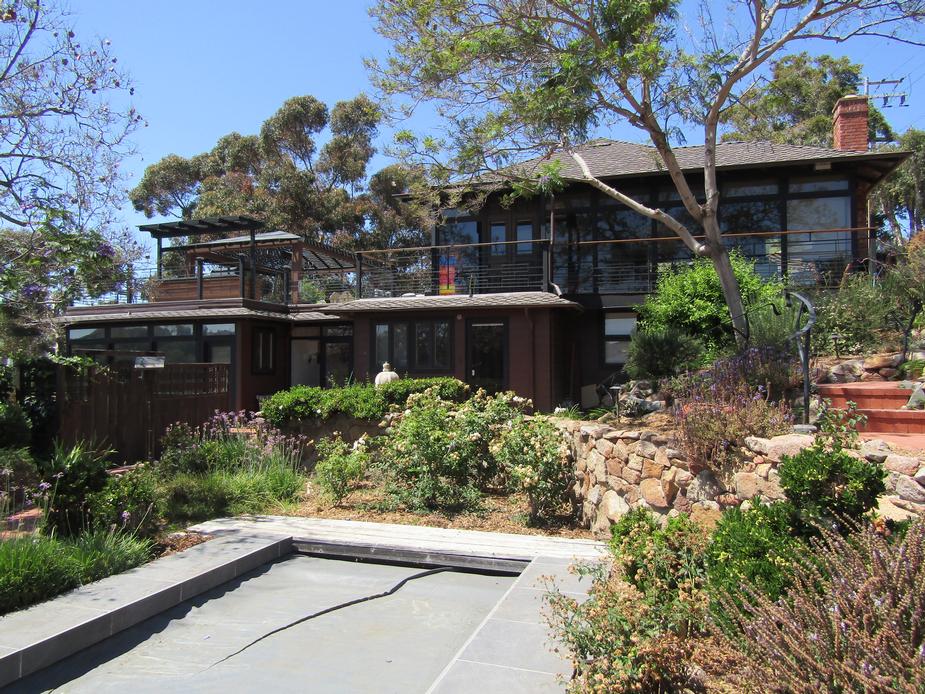 3232 Dove Street in the Uptown Community dates from 1908 and is designated under HRB Criterion B, as the longtime residence of Deborah Szekely, “godmother of the wellness movement,” with renowned spas on both sides of the California-Mexico border. She’s also a prominent philanthropist, who, among other causes, helped raise funds to rebuild the Old Globe Theatre in Balboa Park after it was destroyed by fire, and founded the New Americans Museum and Immigration Learning Center at San Diego’s Liberty Station. She lived in this much-expanded home from 1954 to 2014, hosting many fundraising parties in the large garden to benefit arts, political, academic, and philanthropic causes. Her guests included then-Senator Joe Biden, Nancy Pelosi, Theodor Geisel (aka Dr. Seuss), and Dr. Walter and Judith Munk. In 2012, Mexican president Felipe Calderón awarded her the Order of the Aztec Eagle, the highest Mexican government decoration given to foreign nationals whose work has benefitted Mexico or its citizens. 3232 Dove Street in the Uptown Community dates from 1908 and is designated under HRB Criterion B, as the longtime residence of Deborah Szekely, “godmother of the wellness movement,” with renowned spas on both sides of the California-Mexico border. She’s also a prominent philanthropist, who, among other causes, helped raise funds to rebuild the Old Globe Theatre in Balboa Park after it was destroyed by fire, and founded the New Americans Museum and Immigration Learning Center at San Diego’s Liberty Station. She lived in this much-expanded home from 1954 to 2014, hosting many fundraising parties in the large garden to benefit arts, political, academic, and philanthropic causes. Her guests included then-Senator Joe Biden, Nancy Pelosi, Theodor Geisel (aka Dr. Seuss), and Dr. Walter and Judith Munk. In 2012, Mexican president Felipe Calderón awarded her the Order of the Aztec Eagle, the highest Mexican government decoration given to foreign nationals whose work has benefitted Mexico or its citizens.
|
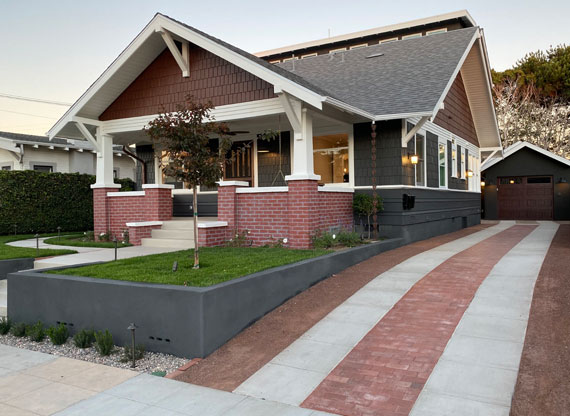 3783 Pioneer Place in the Uptown Community is the Alwyn and Emily Patterson House (1915), designed in the Craftsman style and designated for its Craftsman style architecture under HRB Criterion C. Among the stylistic elements retaining integrity are a cross-gabled roof, overhanging eaves with exposed rafters, decorative attic vents, triangular knee brackets, wood shingle siding above the wood band at the sill line and varied reveal horizontal wood siding below, a partial-width front porch supported by battered posts and brick piers, original front door, and wood-framed double-hung and fixed windows. The designation excludes the detached two-story 1928 apartment building, the detached 2021 garage, and the 2021 two-story addition. Photo courtesy apartments.com 3783 Pioneer Place in the Uptown Community is the Alwyn and Emily Patterson House (1915), designed in the Craftsman style and designated for its Craftsman style architecture under HRB Criterion C. Among the stylistic elements retaining integrity are a cross-gabled roof, overhanging eaves with exposed rafters, decorative attic vents, triangular knee brackets, wood shingle siding above the wood band at the sill line and varied reveal horizontal wood siding below, a partial-width front porch supported by battered posts and brick piers, original front door, and wood-framed double-hung and fixed windows. The designation excludes the detached two-story 1928 apartment building, the detached 2021 garage, and the 2021 two-story addition. Photo courtesy apartments.com
|
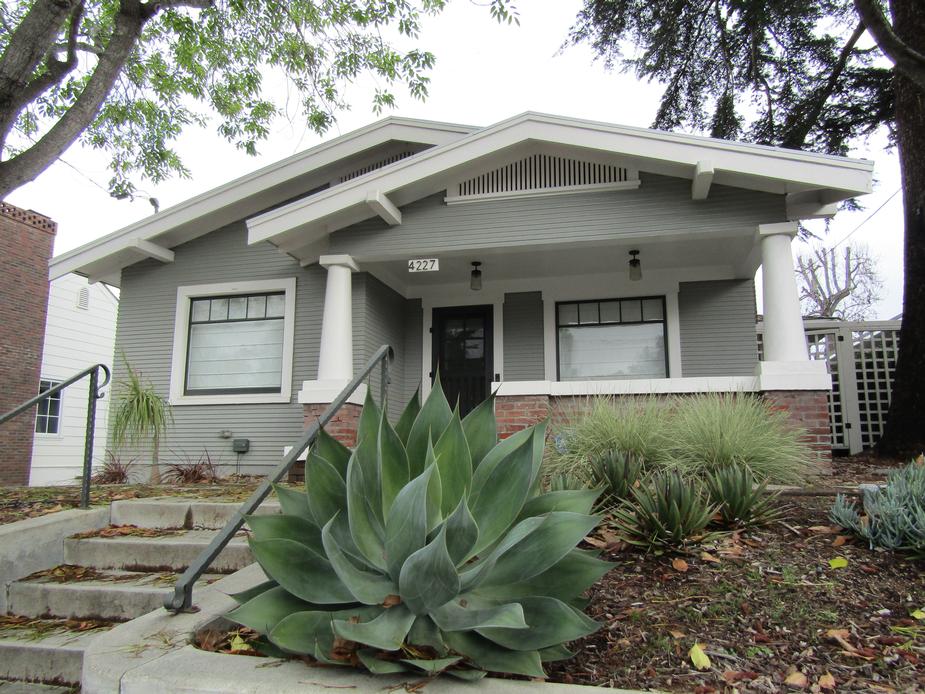 4227 Jackdaw Street in the Uptown Community is the John S. Graves Spec House #2, designated under HRB Criterion C for architecture. Built in 1921, it embodies the distinctive characteristics of the Craftsman style and retains integrity from its date of construction. The Craftsman features include a low-pitched, cross-gable roof with overhanging eaves; exposed rafter tails; decorative beams; narrow horizontal wood siding; a partial-width, half-walled front porch with a front gable roof; stucco-clad, tapered round columns over brick piers; a brick chimney; wood-framed, double-hung and fixed windows. The designation excludes the 1985 and 2019-2020 additions and the attached ADU (accessory dwelling unit). 4227 Jackdaw Street in the Uptown Community is the John S. Graves Spec House #2, designated under HRB Criterion C for architecture. Built in 1921, it embodies the distinctive characteristics of the Craftsman style and retains integrity from its date of construction. The Craftsman features include a low-pitched, cross-gable roof with overhanging eaves; exposed rafter tails; decorative beams; narrow horizontal wood siding; a partial-width, half-walled front porch with a front gable roof; stucco-clad, tapered round columns over brick piers; a brick chimney; wood-framed, double-hung and fixed windows. The designation excludes the 1985 and 2019-2020 additions and the attached ADU (accessory dwelling unit).
|
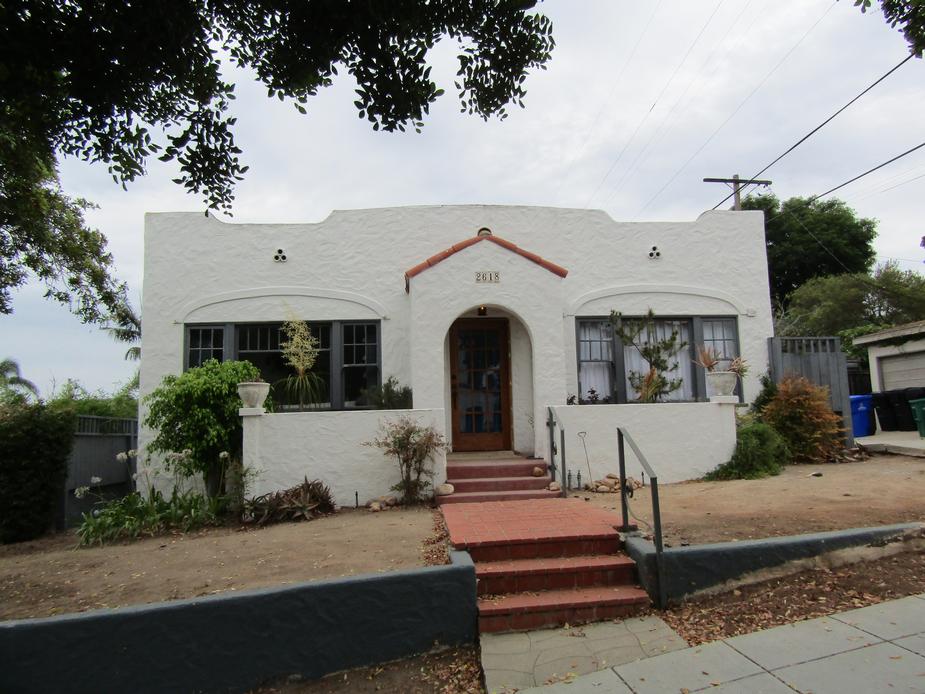 2618 Myrtle Avenue in North Park was built in 1927 and is named the Dean and Lillian Dobson House. It meets HRB Criterion C for its architecture in the Mission Revival style with Spanish Colonial Revival influences. The resource retains integrity and distinctive, original design characteristics, such as a stepped mission style parapet, barrel tile roof, covered front patio with arched supports, round clay tile attic vents, battered stucco end chimney with an arched top, arched stucco window molding, a symmetrical front facade, original divided-light wood French entry door, one-over-one and divided-light wood sash double-hung and tripartite windows, and original hand-troweled stucco with a sand finish. The designation includes the original detached garage. 2618 Myrtle Avenue in North Park was built in 1927 and is named the Dean and Lillian Dobson House. It meets HRB Criterion C for its architecture in the Mission Revival style with Spanish Colonial Revival influences. The resource retains integrity and distinctive, original design characteristics, such as a stepped mission style parapet, barrel tile roof, covered front patio with arched supports, round clay tile attic vents, battered stucco end chimney with an arched top, arched stucco window molding, a symmetrical front facade, original divided-light wood French entry door, one-over-one and divided-light wood sash double-hung and tripartite windows, and original hand-troweled stucco with a sand finish. The designation includes the original detached garage.
|
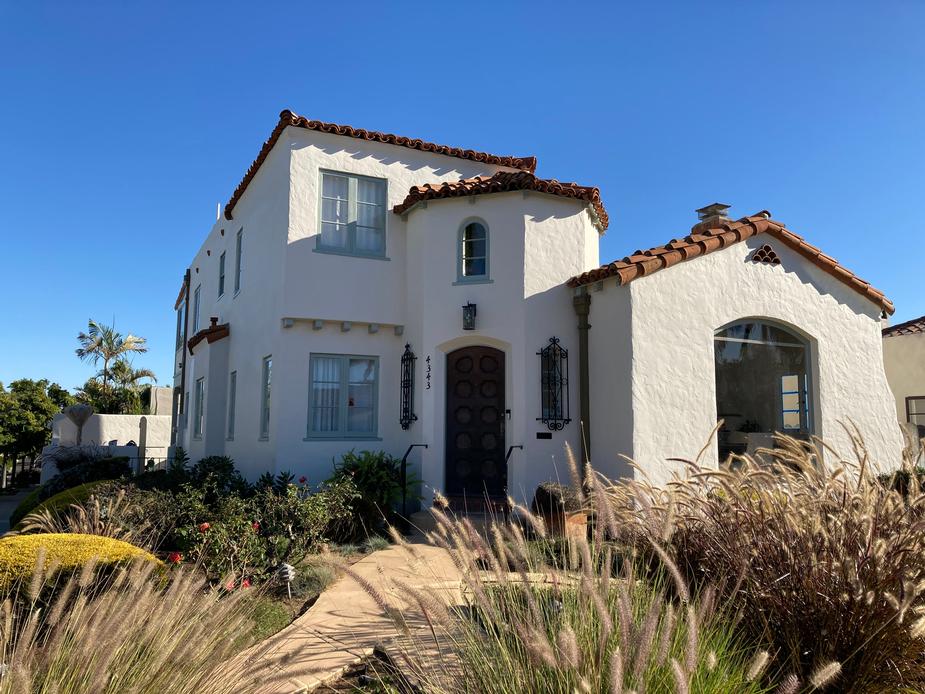 4343 Trias Street in the Uptown Community is the Pear and Helen Pearson Spec House #1, built in 1928. It meets HRB Criteria C for its architecture, and D, as a notable work of Master Builder Pear Pearson. It embodies and retains distinctive characteristics of the Spanish Colonial Revival style as well as integrity. It exhibits an asymmetrical facade, red tile roof with little eave overhang, varied roof forms, central tower, stucco exterior, arched focal window, cantilevered second floor with decorative beams, clay tile attic vent, wood sleeping porch, wood paneled entry door, curved wing wall, decorative iron window grills, and wood-framed windows. Both interior elements included in the designation—the living room ceiling beams and fireplace—are original to the 1928 construction and are designed consistent with the home’s Spanish Colonial Revival style. Master Builder Pearson was a prominent and accomplished building contractor responsible for the construction of many quality houses in San Diego. This home continues to reflect his original design, intent, and aesthetic, and demonstrates high-quality architecture and craftsmanship associated with him. The designation includes the original garage with maid’s quarters, living room ceiling beams, and living room fireplace. It excludes the 1969 addition. 4343 Trias Street in the Uptown Community is the Pear and Helen Pearson Spec House #1, built in 1928. It meets HRB Criteria C for its architecture, and D, as a notable work of Master Builder Pear Pearson. It embodies and retains distinctive characteristics of the Spanish Colonial Revival style as well as integrity. It exhibits an asymmetrical facade, red tile roof with little eave overhang, varied roof forms, central tower, stucco exterior, arched focal window, cantilevered second floor with decorative beams, clay tile attic vent, wood sleeping porch, wood paneled entry door, curved wing wall, decorative iron window grills, and wood-framed windows. Both interior elements included in the designation—the living room ceiling beams and fireplace—are original to the 1928 construction and are designed consistent with the home’s Spanish Colonial Revival style. Master Builder Pearson was a prominent and accomplished building contractor responsible for the construction of many quality houses in San Diego. This home continues to reflect his original design, intent, and aesthetic, and demonstrates high-quality architecture and craftsmanship associated with him. The designation includes the original garage with maid’s quarters, living room ceiling beams, and living room fireplace. It excludes the 1969 addition.
|
At the April 2024 HRB meeting, the board designated two historical resources, including the San Diego International Sports Arena, and a residence. They also heard courtesy presentations on the Arnold and Choate’s-North Florence Heights Historic District nomination to the National Register, which is expected to be approved at the State Historical Resources Commission meeting on May 3, 2024.
Mission Hills Heritage, with its consultant Architectural Resources Group, nominated this mostly residential historic district that spans the years 1907-1950 under two National Register Criteria. They are Criterion A, for association with events that have made a significant contribution to San Diego’s development, and criterion C, for architecture by master architects, such as Richard Requa, William Templeton Johnson, Emmor Brooke Weaver, Frank Mead, and by master builders, such as Martin V. Melhorne and Alexander Schreiber. A substantial number of Craftsman style buildings are interspersed with homes representing other early 20th-century architectural styles, such as Mission/Spanish Colonial Revival, Colonial Revival, Mediterranean/Italian Renaissance Revival, Tudor Revival, Prairie School, and American Foursquare/Classic Box. Read the draft of the nomination online.
The nomination, which SOHO and HRB staff strongly support, includes about 266 historic resources, of which 40 are already listed on the local historic register, spread across 69 acres bounded by canyons in some places. Bruce Coons, SOHO’s Executive Director, testified that the district is notable for its diversity and density of architectural styles. “The City should have [created this district] as much as 30 years ago,” he said. He also corrected misinformation stated in earlier public comment by explaining there is no blanket property tax advantage applied to historic districts, only tax reductions available to individual property owners by application.
Staff announced that the City of San Diego 2024 Preservation Awards will be announced in May and celebrated at the HRB meeting on May 23. In addition, the City Council is expected to approve steep increases in processing fees for historical resources and other property, also in May. Fees are set to roughly triple in cost for submitting local designation nominations and applications for Mills Act contracts.
Here is information about the two newly designated structures:
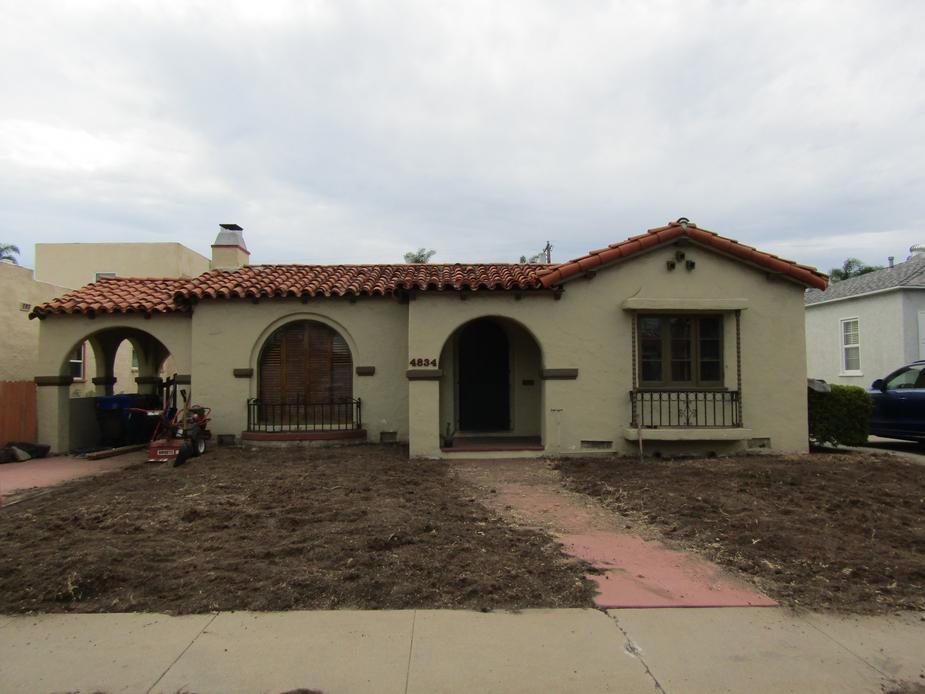 4834 Marlborough Drive in the Kensington-Talmadge Community is a Spanish Colonial Revival style house built in 1931. Named the John and Elizabeth Suchy/Charles Salyers House it is designated under HRB Criteria C (architecture) and D (master architect). The resource’s Spanish Colonial Revival design elements include an asymmetrical facade; stucco cladding; varied roof forms including gable, shed, and flat roofs; barrel tile roof cover; decorative attic vents; arched focal window; arched front entry; arched wooden front door; decorative window spindles and grilles; and wooden divided-light casement windows. A notable work of Master Architect Salyers, this is an early example of his quality design and craftsmanship and one of several San Diego homes that have been designated. In addition to the Spanish Colonial Revival style, Salyers also designed Tudor Revival and Streamline Moderne residences. The designation includes the original detached garage. 4834 Marlborough Drive in the Kensington-Talmadge Community is a Spanish Colonial Revival style house built in 1931. Named the John and Elizabeth Suchy/Charles Salyers House it is designated under HRB Criteria C (architecture) and D (master architect). The resource’s Spanish Colonial Revival design elements include an asymmetrical facade; stucco cladding; varied roof forms including gable, shed, and flat roofs; barrel tile roof cover; decorative attic vents; arched focal window; arched front entry; arched wooden front door; decorative window spindles and grilles; and wooden divided-light casement windows. A notable work of Master Architect Salyers, this is an early example of his quality design and craftsmanship and one of several San Diego homes that have been designated. In addition to the Spanish Colonial Revival style, Salyers also designed Tudor Revival and Streamline Moderne residences. The designation includes the original detached garage.
|

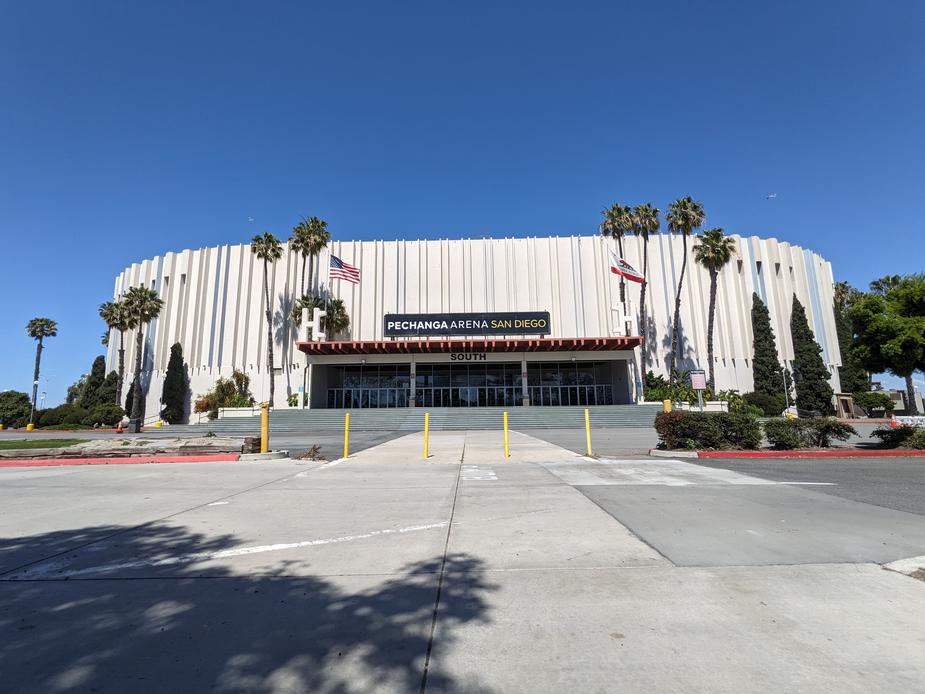 3500 Sports Arena Boulevard in the Midway area is well known to generations as the San Diego International Sports Arena. This venue for sports, concerts, and other events is designated under HRB Criteria A and B, with a period of significance of 1966-1974, and under Criterion C, architecture for the year it was built, 1966. Under A, the building qualifies as a special element of the Midway-Pacific Highway Community and the City’s historical, social, and economic development. Constructed during the Post WWII period, it represents a time of growth throughout San Diego and the movement to expand the City’s economic ventures into new industries comparable to other major cities in the country. The International Sports Arena was the most important catalyst in the Midway neighborhood’s transformation from WWII housing into a lively entertainment and commercial hub. It was also one of the first modern stadiums/arenas in San Diego. Criterion B is met by the arena’s association with Robert Breitbard, a significant person in San Diego sports history. Breitbard was instrumental in acquiring the land and funding for the construction of the International Sports Arena in 1966. From 1966 to 1974, he was the owner of the San Diego Gulls, a Western Hockey League franchise and the arena’s first tenants. Breitbard also founded the San Diego Rockets, a National Basketball Association franchise that played at the arena from 1967 to 1971. His efforts to construct the International Sports Arena and general promotion of sports in San Diego as a member of the Greater San Diego Sports Council and founder of the San Diego Hall of Champions helped to attract major sports franchises to the city. For Criterion C, the arena embodies and retains distinctive characteristics and integrity of the New Formalist style: monumental scale, raised platform, fins mimicking classical colonnades, strict symmetry and formality, a flat roof, and ornamental concrete. The designation excludes the temporary storage container, the temporary office building northeast of the arena and the structures located at 3580, 3570, 3494, 3350, 3250, 3240, and 3220 Sports Arena Boulevard. Photos The San Diego International Sports Arena, two years after it opened in 1968, and today, operating under a sponsor’s name. Postcard by Photography House, San Diego. Dexter Press 3500 Sports Arena Boulevard in the Midway area is well known to generations as the San Diego International Sports Arena. This venue for sports, concerts, and other events is designated under HRB Criteria A and B, with a period of significance of 1966-1974, and under Criterion C, architecture for the year it was built, 1966. Under A, the building qualifies as a special element of the Midway-Pacific Highway Community and the City’s historical, social, and economic development. Constructed during the Post WWII period, it represents a time of growth throughout San Diego and the movement to expand the City’s economic ventures into new industries comparable to other major cities in the country. The International Sports Arena was the most important catalyst in the Midway neighborhood’s transformation from WWII housing into a lively entertainment and commercial hub. It was also one of the first modern stadiums/arenas in San Diego. Criterion B is met by the arena’s association with Robert Breitbard, a significant person in San Diego sports history. Breitbard was instrumental in acquiring the land and funding for the construction of the International Sports Arena in 1966. From 1966 to 1974, he was the owner of the San Diego Gulls, a Western Hockey League franchise and the arena’s first tenants. Breitbard also founded the San Diego Rockets, a National Basketball Association franchise that played at the arena from 1967 to 1971. His efforts to construct the International Sports Arena and general promotion of sports in San Diego as a member of the Greater San Diego Sports Council and founder of the San Diego Hall of Champions helped to attract major sports franchises to the city. For Criterion C, the arena embodies and retains distinctive characteristics and integrity of the New Formalist style: monumental scale, raised platform, fins mimicking classical colonnades, strict symmetry and formality, a flat roof, and ornamental concrete. The designation excludes the temporary storage container, the temporary office building northeast of the arena and the structures located at 3580, 3570, 3494, 3350, 3250, 3240, and 3220 Sports Arena Boulevard. Photos The San Diego International Sports Arena, two years after it opened in 1968, and today, operating under a sponsor’s name. Postcard by Photography House, San Diego. Dexter Press
|
All photos are from the California Historical Resources Inventory Database (CHRID), except where noted otherwise. The above designations were reviewed and approved by the City of San Diego Historical Resources Board (HRB), the County of San Diego Historic Site Board (HSB), or the Coronado Historic Resources Commission.
|
2025
2024
2023
2022
2021
2020
2019
2018
2017
2016
2015
|











